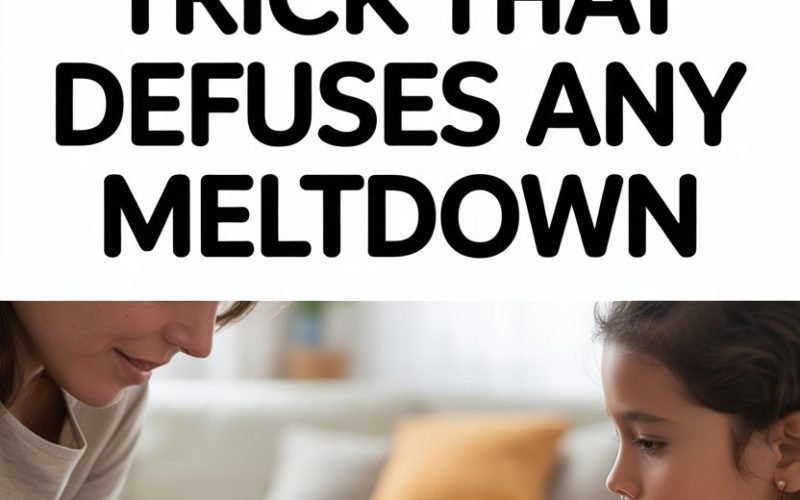Meltdowns. Tantrums. Nuclear-level toddler explosions.
Every parent knows the feeling: you’re in the supermarket line, or about to leave for school, and suddenly your darling child is lying on the floor, howling like a banshee auditioning for a horror flick.
If only there was a magic button to press.
There is. And it only takes 10 seconds.
The Science Behind the 10-Second Pause
Children lose it. Adults lose it. (Ever yelled at a computer that crashed before saving your spreadsheet? Just me? Okay.)
During a meltdown, a child’s brain is all storm, no sunshine. The amygdala—the little almond-shaped bit in charge of fight or flight—goes into overdrive.
Logic and reason? They’ve nipped out for tea.
Researchers at Yale Child Study Center found that when parents react with immediate intensity, it actually fires up the child’s stress response even more. Picture throwing petrol on a barbecue. Not ideal.
But pausing—just 10 seconds—signals to your child’s brain that things are safe. You’re not about to go off like a bottle of shaken soda. This pause is your secret weapon.
What Actually Happens in 10 Seconds
Ten seconds sounds laughably short until you’re watching a two-year-old try to swan-dive from a supermarket trolley. But here’s what happens:
- Your breathing slows. (Hold in, hold out.)
- Your face relaxes.
- Your fists unclench.
- Your child sees you modelling calm.
Psychologists call this co-regulation. Kids borrow your calm when they can’t find their own. Even if you’re faking it at first, your body and brain start to believe you.
Ten seconds can feel like an eternity in the middle of a meltdown. That’s good. You’re interrupting everyone’s panic loop.
Practicing the Pause
Anything worth doing takes a bit of practice, and the 10-second trick is no different. Here’s how to get started:
- Spot the signs: clenched jaw, raised voice, urge to throw your own parent-style tantrum.
- Decide: “I’m pausing for 10.”
- Focus on your breath. If you need to, count on your fingers (under your breath, unless you want to look like you’re casting a spell).
- Don’t fix, solve, or talk. Just be.
Your child might stare at you like you’ve grown an extra ear. Good. They’re noticing. You’re showing them that even when things feel wild, you can choose to pause.
Saying Nothing Is the Secret Sauce
It’s tempting to fill the silence. “Darling, if you just stop crying, I’ll—” Nope. The 10-second trick is not about talking. In fact, words can make things worse when a child is emotionally flooded.
A study from the University of Wisconsin-Madison revealed that children process far less language during emotional overload. Your “let’s use our words” is basically static at this stage.
Your calm, quiet presence is more powerful than a lecture. Silence, for once, is golden.
What If You Mess Up?
Every parent has snapped. (If you haven’t, I’d like to borrow your halo.) If you forget to pause and instead bark out “Enough!”—that’s okay. You get another go.
Children are remarkably forgiving. After the storm, try this: “I got frustrated and yelled. Next time, I’ll try to take a pause. Want to help me remember?”
This shows them that even grown-ups practice.
Repair, as Dr. Becky Kennedy explains, is the unsung hero of parenting. It’s not about never getting it wrong; it’s about making it right after.
When the Trick Feels Too Simple
If you’re thinking, “Nice try, but my child is a category-five hurricane,” you’re not alone. Ten seconds won’t cure all meltdowns. It won’t make your child brush their teeth without protest or suddenly adore broccoli.
What it does is shift the energy—yours and theirs. Meltdowns are contagious: you catch their stress, they catch yours. The pause interrupts the spiral. It gives both of you a fighting chance to reset.
Tweaking the Trick for Different Ages
Toddlers don’t yet have the words or impulse control to explain, “I’m upset because you peeled my banana wrong.” (If you know, you know.)
With little ones, just crouch to their level and pause. Older kids? Say, “I need a second,” then model the pause. Adolescents? They might roll their eyes, but secretly, they clock your self-control.
It’s not about pretending the problem isn’t there. It’s about showing that you’re willing to slow things down, even when things feel frantic.
Cueing Up Your Pause in Public
Meltdowns have a knack for choosing the most embarrassing locations: the chemist, the school gate, or while visiting relatives who ‘never had this trouble’ (bless them).
Ten seconds feels longer when there’s an audience, but it works. Focus on your child, not on judging eyes.
Public meltdowns are universal; the pause signals to others that you’re handling it. Or faking it ‘til you make it. Both count.
If you want a subtle cue, look away and take a slow sip of water. This also doubles as a handy prop to avoid blurting out something you’ll regret.
Using the Trick for Yourself
This isn’t just for the kids. Parents reach their boiling point, too. If you’re ready to start shouting at everyone—including the cat—call a time-out for yourself.
Step into the loo, count to ten, breathe. No shame. In fact, studies from the Center for Parent and Teen Communication show parents who model self-soothing raise children who can self-soothe as well.
You’re not losing control; you’re demonstrating a skill that will serve your kids for life.
When to Seek Extra Help
If meltdowns are shaking your family daily, or if you worry your child’s reactions seem far beyond what’s typical, reach out to your GP, health visitor, or a qualified child psychologist.
Sometimes bigger feelings need bigger support.
The 10-second trick is a tool, not a cure-all. Reach for it, but remember—nobody parents alone, and help is always an option.
Why Ten Seconds Makes All the Difference
Pausing for ten seconds during a meltdown won’t win you a gold star, but it will change the trajectory of that moment.
You’re not just stalling for time; you’re showing your child (and yourself) that feelings are safe, manageable, and not emergencies to be squashed or feared.
With enough practice, those ten seconds start to stretch. Tempers cool. Everyone walks away with more dignity—and, occasionally, with their groceries still in the trolley.
Now, if only there were a 10-second trick for unearthing lost socks. But that’s another column.





